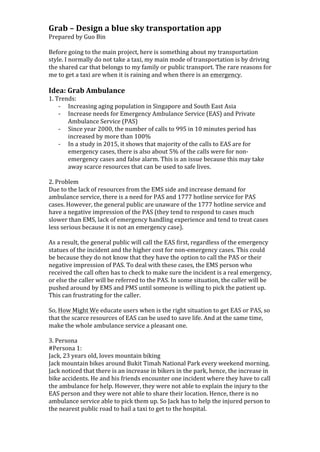Grab – design a blue sky transportation app (final)
- 1. Grab – Design a blue sky transportation app Prepared by Guo Bin Before going to the main project, here is something about my transportation style. I normally do not take a taxi, my main mode of transportation is by driving the shared car that belongs to my family or public transport. The rare reasons for me to get a taxi are when it is raining and when there is an emergency. Idea: Grab Ambulance 1. Trends: - Increasing aging population in Singapore and South East Asia - Increase needs for Emergency Ambulance Service (EAS) and Private Ambulance Service (PAS) - Since year 2000, the number of calls to 995 in 10 minutes period has increased by more than 100% - In a study in 2015, it shows that majority of the calls to EAS are for emergency cases, there is also about 5% of the calls were for non- emergency cases and false alarm. This is an issue because this may take away scarce resources that can be used to safe lives. 2. Problem Due to the lack of resources from the EMS side and increase demand for ambulance service, there is a need for PAS and 1777 hotline service for PAS cases. However, the general public are unaware of the 1777 hotline service and have a negative impression of the PAS (they tend to respond to cases much slower than EMS, lack of emergency handling experience and tend to treat cases less serious because it is not an emergency case). As a result, the general public will call the EAS first, regardless of the emergency statues of the incident and the higher cost for non-emergency cases. This could be because they do not know that they have the option to call the PAS or their negative impression of PAS. To deal with these cases, the EMS person who received the call often has to check to make sure the incident is a real emergency, or else the caller will be referred to the PAS. In some situation, the caller will be pushed around by EMS and PMS until someone is willing to pick the patient up. This can frustrating for the caller. So, How Might We educate users when is the right situation to get EAS or PAS, so that the scarce resources of EAS can be used to save life. And at the same time, make the whole ambulance service a pleasant one. 3. Persona #Persona 1: Jack, 23 years old, loves mountain biking Jack mountain bikes around Bukit Timah National Park every weekend morning. Jack noticed that there is an increase in bikers in the park, hence, the increase in bike accidents. He and his friends encounter one incident where they have to call the ambulance for help. However, they were not able to explain the injury to the EAS person and they were not able to share their location. Hence, there is no ambulance service able to pick them up. So Jack has to help the injured person to the nearest public road to hail a taxi to get to the hospital.













